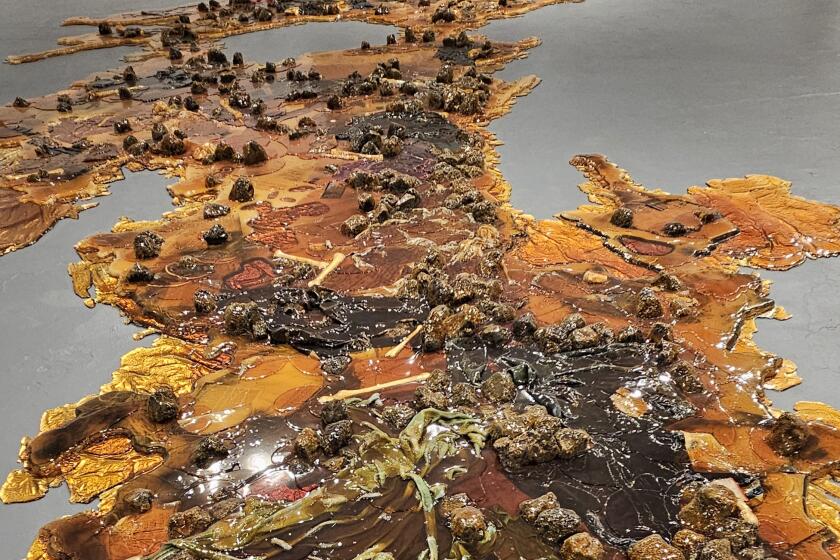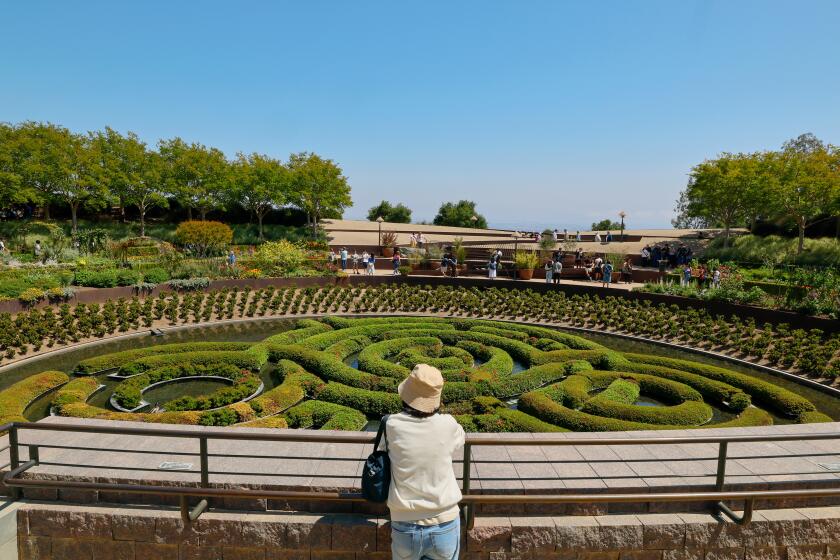Tacked Down and Faded, Copper Curtain Faces an Uncertain Future : Thousand Oaks: Some call it art. Others call it ugly. City officials ponder ways to enliven the Arts Plaza work. But the artist likes it just the way it is.
It was supposed to move like a wheat field in the wind. Instead, it lies flat against the side of the Civic Arts Plaza, a dull brown copper curtain barely stirring in the afternoon breeze.
Fearing that the strips of copper might somehow fly off and land on the windshield of some unsuspecting motorist, the city clamped them tightly into place, preventing the kind of undulating movement originally planned.
And little more than six months after its installation, the curtain--which was created by architect Antoine Predock to break up the barren eastern-facing wall of the building--has almost completely lost its metallic shimmer.
Some call the $150,000 sculpture too dull. Some call it ugly. And no one at City Hall seems to think it a success.
“The biggest problem with it now is that it is too plain,” Building Manager Ed Johnduff said. “It is just sitting there. I guess people want something else to happen with it.”
City Manager Grant Brimhall said he has heard similar complaints.
“There have been suggestions that something needs to happen to make the curtain be more exciting,” he said.
The city is mulling over ways to make the curtain more appealing without spending a fortune. One idea being tossed around is to somehow etch or polish the image of the Exuberant Muse--the informal symbol of the Civic Arts Plaza--onto the curtain.
“I’d love to see that there,” Councilwoman Judy Lazar said. “It would be nice to have the dancer peeking through the curtain or something.”
*
Another idea being considered by the Percent for the Arts Committee, which selects art for the city’s public buildings and spaces, is to liven up the curtain with a depiction of a sprawling oak tree, the city’s symbol. The committee is discussing these possibilities with local artists.
An image might be etched onto the surface of the panels with some sort of chemical, or individual panels could be removed, buffed and polished back to a bright coppery color, then replaced in the shape of the dancer or of an oak.
The curtain’s creator was dismayed to hear his work might be altered.
“It is surprising to me because I consider it complete,” Predock said in a telephone interview from his Albuquerque, N.M., office. “It doesn’t need anything. It is beautiful.”
Its abstract nature is entirely intentional, he said, and designed to blend with the local landscape.
“To etch an image would defeat the abstraction of the curtain,” he said. “It would be a terrible thing to do.”
Brimhall said the city will not do anything without consulting Predock. But since the city owns the piece, it has final say on what happens to it.
From the time it was first installed late last summer, the sculpture has been regarded with suspicion by residents.
But as it has aged, fading to a muted grayish-brown, it has become practically impossible to find anyone in Thousand Oaks who actually likes it.
And from the freeway, it is a puzzle to many who first come across it.
“We had guests coming in from Hawaii,” said former council member and county Supervisor Madge Schaefer. “On the way back from the airport, we drove by it. And they said, ‘What is that?’ We said, ‘That’s our cultural arts center.’ They said, ‘Yeah, but what is that big brown rusting thing on the side of it?’ ”
“We said, ‘That’s art,’ ” Schaefer said.
Technically, the curtain is art. But art being highly subjective, there are vastly differing opinions. Or as Brimhall puts it, “it’s in the eye of the beholder.”
*
The glossy monthly Architecture Magazine devoted much of its March issue to Predock, featuring the Civic Arts Plaza as one of his triumphs.
The writer gushed that, viewed from the freeway, “the Civic Arts Plaza conveys the authority of an Acropolis--a welcome metaphor in the arid landscape of Thousand Oaks.”
“Its planar surface, sheathed in a tapestry of thin copper panels, symbolizes the stage behind it,” it goes on. “Sharp and geometric, the fly tower’s facade establishes a complementary threshold to the Conejo Valley, which unfolds in expansive undulations beyond.”
Eventually, the curtain will oxidize to a soft green color. But because the air in Thousand Oaks is so dry, the process will take at least five years, maybe longer. The gradual fading going on now is merely the beginning of the process, Brimhall said.
“It’s doing what it is supposed to do,” he said. “Unfortunately, given the nature of our air it could take 25 years.”
More to Read
The biggest entertainment stories
Get our big stories about Hollywood, film, television, music, arts, culture and more right in your inbox as soon as they publish.
You may occasionally receive promotional content from the Los Angeles Times.






